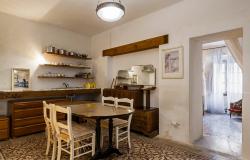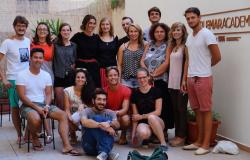Words by Pat Eggleton
I often think that one of the reasons I feel at home in Sicily is that there are dry-stone walls everywhere, reminding me of the dry-stone walls of Gloucestershire, where I spent a lot of my childhood. The dry-stone walls of that English county are not bleached white by the sun and you see less of them today but in Sicily the walls are all well maintained though, mysteriously, you never see anyone working on them. No one is sure as to the original purpose of the dry-stone walls of Sicily: they may have been part of an irrigation system, an attempt to lessen the effects of landslides or simply built to fence land off. To me, they have a beauty all of their own.
In the mid-twentieth century, a Modican man who made his home in Britain also remembered dry-stone walls, but in his case it was the dry-stone walls of Ireland which reminded him of Sicily. He was Raffaele Giardina, a writer who remains virtually unknown in his home town: Born in Modica in 1898, Raffaele Giardina was the last of ten children in his family and his mother died in childbirth. The family was poor and his father Carmelo had a bakery opposite the Church of Santa Maria in Modica Bassa. But the flood of 1902 destroyed his premises and the family was reduced to penury.
Raffaele nevertheless managed to obtain a high school diploma and, called up in 1917 and sent to Rome, he studied there and graduated in Economics in 1920. He loved the cosmopolitan atmosphere of Rome but, a committed anti-fascist, he left Italy for South Africa in 1927. There he studied, found work on a tobacco plantation run by Italians and, in the 1930s, met and married an Englishwoman with whom he settled in Taunton [Somerset, England].
In Taunton Raffaele became active in local agricultural organizations and in the International Friendship League, a movement promoting peace and friendship between people of different nations. The key text of the movement was “The Anatomy of Peace” by Emery Reves, which promoted the idea that only a world government could guarantee world peace. Raffaele was impressed by this idea and in 1953 he published “Verso il Sovrumanesimo” (a book about his ideas on
world federalism). These ideas may seem naïve today but immediately after the devastation and barbarity of World War II they were attractive to many people. In another book, “Modica”, published in English as “A Boy in Sicily” and translated by Muriel Currey, Raffaele writes, of a boys’ brawl he was involved in,
“ From the bloodless battles of boys to the quarrels between man and man and to the wars between nations, the transition is gradual, but obvious…… For how many centuries more is the human race condemned to offer such a lamentable spectacle? Or is the demon of suspicion and hate to be eternally victorious?”
 In “Modica” Raffaele also writes of happier childhood memories and my personal favourite is the chapter in which he describes his first view of the sea. The sea is not far from Modica – these days, no more than a twenty-minute drive – but in the early twentieth century Modica to Pozzallo was a longer journey and it is quite feasible that a child from a poor family would never have seen the sea. One day, Raffaele persuades one of his father’s customers to give him a lift in his cart to Pozzallo:
In “Modica” Raffaele also writes of happier childhood memories and my personal favourite is the chapter in which he describes his first view of the sea. The sea is not far from Modica – these days, no more than a twenty-minute drive – but in the early twentieth century Modica to Pozzallo was a longer journey and it is quite feasible that a child from a poor family would never have seen the sea. One day, Raffaele persuades one of his father’s customers to give him a lift in his cart to Pozzallo:
“I climbed down from the cart, and in a few steps I was on a wide, sandy shore, beyond which stretched a vast expanse of blue. I plodded on with difficulty, and when I reached the water’s edge I realized that what lay before me was the sea, ruffled by a little breeze. I stood quite still, absorbed in the vision of the brilliant sunshine, the vivid colour of the sea and the dazzling yellow of the sands. The ripples on the surface, the sound of the waves breaking gently at my feet, the freshness of the air, the sea and the sands extending further then the eye could reach, overwhelmed me – here were sights and sounds far beyond the simple, untaught imagination of a small boy.”
Raffaele had to go home on foot, which took him until nightfall, and when he arrived he was beaten for his efforts by his father. Let us hope that his sight of the sea was worth it.
In “Memories and Ideals” [1950] first written in English, Raffaele tells us of his encounter with a girl called Maria in an oleander grove:
 “We had never been so near to an oleander grove. The colour and scent of the flowers captivated us. We looked and looked at them, drawing with our small hands some clusters nearer to our faces, to please still more our eyes and our nostrils And then: why? And how? Without even knowing what we were doing, we were kissing one another. It was the chaste, guileless kiss of nature. It was like perceiving a ray of sunlight, or a wavelet gently spreading on the sea shore…..In my old age…. I hope to be able to kiss again with the innocence of childhood. Maria and I will then walk once more, hand in hand, along the drive leading to the old grove in the Sicilian hinterland…. And in Maria’s face I do hope to see reflected the lineaments of all the people I have known”.
“We had never been so near to an oleander grove. The colour and scent of the flowers captivated us. We looked and looked at them, drawing with our small hands some clusters nearer to our faces, to please still more our eyes and our nostrils And then: why? And how? Without even knowing what we were doing, we were kissing one another. It was the chaste, guileless kiss of nature. It was like perceiving a ray of sunlight, or a wavelet gently spreading on the sea shore…..In my old age…. I hope to be able to kiss again with the innocence of childhood. Maria and I will then walk once more, hand in hand, along the drive leading to the old grove in the Sicilian hinterland…. And in Maria’s face I do hope to see reflected the lineaments of all the people I have known”.
I hope that this introduction has given you a flavour of the works of this gentle, unassuming writer. Raffaele visited Modica with his wife just once more, in 1954, and he died in Taunton in 1955. I like to imagine that he sometimes visited the county of Gloucestershire, which was not so far away, and that the dry-stone walls reminded him of home.








